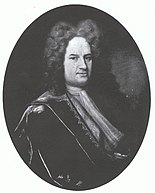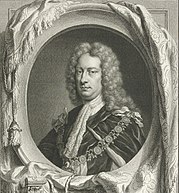This article needs additional citations for verification. (March 2023) |
The second Stanhope–Sunderland ministry (1718–1721) was a continuation of the British Whig government headed by The Earl of Sunderland and The Earl Stanhope. These had taken power in 1717 to form the first Stanhope–Sunderland ministry, and in 1718 they interchanged positions, with Sunderland becoming First Lord of the Treasury.[1] The ministry terminated upon Stanhope's death in February 1721.[2]
Ministry
edit| Office | Name | Term |
|---|---|---|
| First Lord of the Treasury | The Earl of Sunderland | 1718–1721 |
| Northern Secretary | The Earl Stanhope | 1718–1721 |
| Lord Chancellor | The Earl of Macclesfield | 1718–1721 |
| Lord President of the Council | The Earl of Sunderland | 1718–1719 |
| The Duke of Kingston | 1719–1720 | |
| The Viscount Townshend | 1720–1721 | |
| Lord Privy Seal | The Duke of Kingston | 1718–1719 |
| The Duke of Kent | 1719–1720 | |
| The Duke of Kingston | 1720–1721 | |
| Southern Secretary | James Craggs the Younger | 1718–1721 |
| The Lord Carteret | 1721 | |
| First Lord of the Admiralty | The Earl of Berkeley | 1718–1721 |
| Chancellor of the Exchequer | John Aislabie | 1718–1721 |
| Master-General of the Ordnance | The Duke of Marlborough | 1718–1721 |
| Paymaster of the Forces | The Earl of Lincoln | 1718–1720 |
| Robert Walpole | 1720–1721 | |
| Lord Lieutenant of Ireland | The Duke of Bolton | 1718–1720 |
| The Duke of Grafton | 1720–1721 | |
| Lord Steward | The Duke of Argyll | 1718–1721 |
| Lord Chamberlain | The Duke of Newcastle | 1718–1721 |
| Secretary of State for Scotland | The Duke of Roxburghe | 1718–1721 |
References
edit- ^ Starkie, Andrew (2007). The Church of England and the Bangorian Controversy, 1716-1721. Woodbridge: Boydell Press. ISBN 9781843832881.
- ^ McKay, Derek (1973). "The Struggle for Control of George I's Northern Policy, 1718-19". The Journal of Modern History. 45 (3): 367–386. doi:10.1086/241020. ISSN 0022-2801. JSTOR 1879126.

